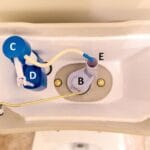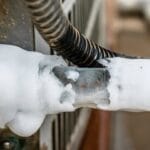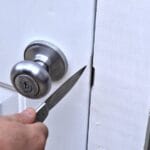Have you ever been in a hurry to finish your laundry, only to find your Roper washer refusing to spin? You’re not alone.
This common issue can throw a wrench in your day, leaving you with damp clothes and a ticking clock. But before you panic or rush to call for repairs, take a moment to explore the possibilities. You might be able to solve this problem yourself, saving both time and money.
We’ll walk you through the reasons why your Roper washer won’t spin and provide simple solutions you can try at home. Ready to get your washer back in action? Let’s dive in and tackle this laundry dilemma together!
Common Causes
Experiencing issues with your Roper washer not spinning can be frustrating. Identifying the common causes can help in resolving the problem effectively. Below are some frequent reasons why your washer may not spin.
Lid Switch Issues
The lid switch is a crucial safety feature. It stops the washer from spinning if the lid is open. A broken lid switch can prevent the washer from spinning. Check if the lid switch clicks when you close the lid. If not, it might be faulty.
Drive Belt Problems
The drive belt connects the motor to the drum. It helps the drum spin. A worn or broken belt can hinder the spinning process. Examine the belt for any signs of wear or damage. Replace it if necessary.
Motor Malfunctions
The motor powers the spinning action. If it malfunctions, the drum won’t spin. Listen for unusual noises coming from the motor. A humming noise might indicate a problem. Consider consulting a technician for motor issues.
Faulty Clutch
The clutch helps the washer reach the right spin speed. A worn-out clutch can affect the spinning. Inspect the clutch for wear. Replacing it might restore the washer’s spinning capability.
Troubleshooting Steps
Is your Roper washer not spinning? It can be frustrating. Many factors can cause this issue. Follow these troubleshooting steps to identify the problem.
You may fix it yourself with some simple checks. Let’s dive into the details.
Checking The Lid Switch
The lid switch ensures the washer spins only when closed. A faulty lid switch might stop spinning.
Open and close the lid firmly. Listen for a clicking sound. No click means the switch might be broken.
Consider replacing the lid switch if needed. This is often a simple fix.
Inspecting The Drive Belt
A worn or broken drive belt can halt spinning. Unplug the washer and locate the belt.
Check for any signs of wear or damage. Replace the belt if it looks worn or is broken.
A new belt can restore the washer’s spinning function.
Testing The Motor
The motor powers the washer’s spin cycle. A malfunctioning motor can stop the spin.
Listen for unusual noises during the spin cycle. If the motor struggles or makes odd sounds, it needs checking.
Consult a professional for motor issues. They require technical skills.
Examining The Clutch
The clutch connects the motor and the drum. A worn clutch can prevent spinning.
Check for signs of wear or damage. Replacing the clutch may solve the spinning issue.
A functioning clutch ensures smooth spinning operations.
Diy Repair Techniques
Facing a Roper washer that won’t spin can be frustrating. Check the lid switch for proper function. Inspect the drive belt for wear and tear. Simple adjustments might get your appliance back in motion.
If your Roper washer won’t spin, don’t rush to call a repair technician. You can save some money and gain satisfaction by fixing it yourself with a few DIY repair techniques. With a bit of patience and a few tools, you might just get your washer back to spinning without much hassle. Here, we’ll cover some of the most common fixes for this problem.Replacing The Lid Switch
One common culprit is the lid switch. If the washer doesn’t spin, this switch might not be engaging properly. First, unplug your washer for safety. Locate the lid switch, usually found under the lid. If it’s broken or worn out, replacing it is straightforward. A quick trip to the hardware store can get you a new switch, and a screwdriver is typically all you need to swap it out. Have you ever wondered how a small part can halt an entire cycle? Try replacing it yourself and see the difference!Changing The Drive Belt
A worn-out drive belt can also be the reason your washer isn’t spinning. To check the belt, tilt the washer back and look underneath. If the belt looks frayed or slack, it’s time for a change. Replacing it requires loosening the old belt and sliding on a new one. This task might seem daunting, but with a bit of determination, you’ll soon have your washer humming along smoothly again. Have you ever felt accomplished after fixing something on your own? This could be one of those moments.Repairing Or Replacing The Motor
Sometimes, the issue is more serious, like a faulty motor. This fix is a bit more advanced but still doable with some guidance. First, ensure the washer is unplugged. Access the motor by removing the back panel. If you notice burnt smells or unusual noises, consider a replacement. This repair might require more time and a bit of research, but it can be a satisfying project. What’s more rewarding than breathing new life into a machine that was once lifeless?Fixing The Clutch
The clutch helps your washer transition between cycles. If it’s worn out, your washer might not spin. To access the clutch, you’ll need to remove the washer’s outer casing. Inspect it for wear or damage. If it’s not functioning well, replacing it can restore your washer’s performance. Tackling this repair might seem like a challenge, but think of the sense of achievement when you hear your washer spin effortlessly again. Each of these DIY techniques not only saves money but also empowers you. Next time your washer won’t spin, you’ll know exactly where to start! Are you ready to take on the challenge and become your own repair hero?
Credit: www.reddit.com
When To Call A Professional
Strange noises or excessive vibrations could mean it’s time to call a professional. If basic troubleshooting fails to fix your Roper washer, expert help ensures proper diagnosis and repair. Avoid further damage by seeking professional assistance when the washer won’t spin properly.
If your Roper washer isn’t spinning, you might be inclined to roll up your sleeves and fix it yourself. But, when is it time to step back and let a professional handle it? Recognizing the right moment to call in an expert can save you time, frustration, and potentially more costly repairs. Let’s explore the scenarios where professional intervention is your best bet.Complex Electrical Issues
Dealing with electrical components can be tricky and hazardous. If your washer’s spin problem seems to stem from wiring or circuit board issues, it’s wise to contact a professional. They have the right tools and knowledge to safely address these problems. Trying to fix electrical issues without proper expertise could lead to more damage. Worse, it might pose a safety risk to you and your household. Remember, it’s better to err on the side of caution when electricity is involved.Persistent Mechanical Problems
Have you tried all the usual troubleshooting steps, and the washer still won’t spin? This might indicate a deeper mechanical issue. Problems like a faulty motor or worn-out bearings require specialized skills and tools to diagnose and repair. If your washer is making unusual noises or vibrating excessively, these could be signs of mechanical failures. A professional can accurately assess the situation and replace or repair the necessary parts. Ask yourself if it’s worth risking further damage by continuing to DIY.Warranty Considerations
Before you attempt any repairs, check if your washer is still under warranty. Many warranties become void if unauthorized repairs are attempted. By calling a professional, you ensure that the warranty remains intact. This could save you from out-of-pocket expenses for parts and labor. Always verify your warranty terms and conditions to make informed decisions about repairs. Choosing to call a professional isn’t admitting defeat. Instead, it’s a strategic move to ensure your washer gets the care it needs. What experiences have you had with DIY repairs? Have they always been successful, or did you find professional help was ultimately necessary? Your Roper washer deserves the best care, and sometimes that means leaving it to the experts.Preventative Maintenance Tips
Your Roper washer is an essential part of your daily routine, but what happens when it suddenly refuses to spin? The frustration is real, but you can mitigate these issues with some preventative maintenance tips. Keeping your washer in top shape not only extends its life but also ensures you won’t be left high and dry when laundry day comes around.
Regular Cleaning
A clean washer is a happy washer. Dust and detergent residue can accumulate in the drum and the spinning mechanism, affecting performance. Regularly wipe down the drum and remove any debris.
Consider running an empty cycle with vinegar or a specialized washing machine cleaner once a month. This helps eliminate stubborn residues and keeps the drum fresh. Have you ever noticed a smell coming from your washer? This simple cleaning trick can help prevent that.
Routine Inspections
Performing routine checks can save you a lot of trouble. Inspect the hoses for leaks and ensure they’re securely fastened. A loose hose can lead to water damage and decreased performance.
Look inside the drum for any foreign objects that might have been overlooked. Coins, buttons, or small clothing items can block the spinning mechanism. Have you ever found a missing sock behind the drum? It’s worth a check!
Avoiding Overloading
Overloading your washer is a common mistake. When you pack too many clothes, the drum struggles to spin effectively. This can wear out the motor faster and lead to costly repairs.
Try splitting large loads into smaller ones. Your clothes will be cleaner, and your washer will thank you by lasting longer. How often do you find yourself cramming clothes in to save time? It might be time to rethink that strategy.
By following these preventative maintenance tips, you can help ensure your Roper washer keeps spinning happily for years. What steps are you already taking to maintain your washer? Share your experiences or questions below!

Credit: www.facebook.com
Selecting Replacement Parts
Facing a Roper washer that won’t spin? Check the motor coupling, lid switch, and drive belt for faults. Choosing the right replacement parts ensures your washer runs smoothly again.
Selecting replacement parts for your Roper washer can feel daunting, especially if you’re dealing with the frustration of a machine that refuses to spin. However, understanding the process and knowing what to look for can make the task much easier. Imagine the satisfaction of fixing your washer yourself and saving money on repair services. Let’s dive into the crucial aspects of finding the right parts to get your washer back in working order.Finding Genuine Parts
Locating genuine parts is essential for maintaining your washer’s performance and longevity. Always look for official Roper parts from authorized dealers or trusted retailers. You can often find these parts online or at local appliance stores, ensuring you get components designed specifically for your washer model. Consider reaching out to Roper’s customer support for guidance on where to purchase authentic parts. They can provide valuable information and help you avoid counterfeit products that might damage your machine. It’s worth spending a bit more time to ensure you’re buying genuine replacements.Cost Considerations
The cost of replacement parts can vary widely, depending on the component and where you buy it. Before making a purchase, compare prices across different platforms to find the best deal. Keep an eye out for discounts or promotions that can save you money. Think about the long-term implications of choosing cheaper, non-genuine parts. While they might seem like a bargain initially, they could lead to more significant problems down the line. Investing in quality parts can save you from repeated repairs and extend your washer’s life.Compatibility Checks
Ensuring compatibility is crucial when selecting replacement parts. Check your washer’s model number and specifications before purchasing any components. This information is usually found on a label inside the door or at the back of the machine. Consult the washer’s manual or look up online resources to confirm that the parts you choose are compatible with your specific model. If you’re uncertain, reach out to the seller or manufacturer for clarification. A simple mistake in compatibility could lead to further malfunctions, so it’s essential to double-check before proceeding. What steps will you take to ensure your Roper washer is up and running again? Consider these factors carefully to make an informed decision and enjoy the satisfaction of a job well done.
Credit: www.youtube.com
Frequently Asked Questions
Why Won’t My Roper Washer Spin?
A faulty lid switch can stop the spin cycle. Check for a broken switch.
How To Fix A Roper Washer That Won’t Spin?
Inspect the drive belt for wear. Replace if needed for spinning function.
Can A Clogged Drain Hose Affect The Spin Cycle?
Yes, a clogged hose can prevent water draining. This stops the spin cycle.
What Role Does The Drive Motor Play In Spinning?
The drive motor powers the spin. A malfunctioning motor stops the spin.
Is It Necessary To Balance The Washer Load?
Yes, unbalanced loads can prevent spinning. Distribute clothes evenly.
Conclusion
Fixing a Roper washer that won’t spin is manageable. Start by checking the lid switch. Ensure it’s working correctly. Next, inspect the drive belt. It should be tight and intact. Also, examine the motor coupling for damage. Look for worn-out parts.
Regular maintenance prevents future issues. Follow the steps to restore your washer’s function. This saves time and money. If problems persist, contact a professional. They offer expert assistance. Keep your washer in top shape. Enjoy clean clothes without hassle. Remember, regular care ensures your appliance works efficiently.
Happy washing!





